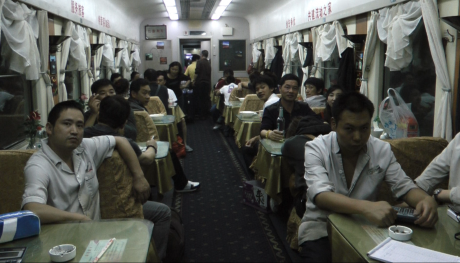In spite of all the heavy industrial landscapes, the loud, crammed, and occasionally frenzied trains, the documentary The Iron Ministry is surprisingly minimalistic and stripped down of any narrative, even for the standards of ethnographic cinema. Director J.P. Sniadecki has worked a few times alongside Harvard’s Sensory Ethnography Lab, an experimental ethnographic cinema collective under the direction of Lucien Castaing-Taylor (one of the creators behind TMT favorite Leviathan). According to their own (also minimalistic) website, the SEL “opposes the traditions of art that are not deeply infused with the real, those of documentary that are derived from broadcast journalism, and those of visual anthropology that mimic the discursive inclinations of their mother discipline.” These aims also describe Sniadecki’s new film, which was shot over the course of three years inside the trains the director traveled on throughout China.
This is not Sniadecki’s first foray into Chinese culture, with two prior examples being 2012’s People’s Park, a single-shot documentary about a park in Chengdu, China, and 2013’s Yumen. The way passengers stare at the screen and the brief moments when the director himself engages with those behind his camera, inquiring about the train system or some particular aspect of the subjects’ lives, makes clear that Sniadecki is an outsider. This creates an interesting childlike naivety that’s also underscored by the editing, which weaves different trains’ journeys into a single voyage, allowing the viewer to continuously marvel the new environment. It becomes clear that Sniadecki is fascinated by Chinese life and culture, and his loose narrative allows us to submerge ourselves in his images and eavesdrop on the occasional chitchat.

One could argue that direct cinema is one of the most ambiguous documentary formats. This holds especially true for a film like The Iron Ministry, which leaves the viewer at their own discretion to focus on several potential aspects of the environment it portrays. We see and listen to frequent conversations between passengers about work and how so many of them seem to be emigrating. Two women talk about horrible conditions in factories and yearn for something better. Another young woman is travelling for the promise of love. Others just seem to be appreciating the view or killing time socializing and smoking with fellow passengers. Class division is also present in Sniadecki’s film, as crowded noisy trains are in contrast with clean, fast first class wagons. For me, watching The Iron Ministry was a very subjective experience: I turned inward my own life, remembering some years back when I practically had three different homes in three different cities and spent a large portion of my time inside buses, on the late night highways.
However, The Iron Ministry is not a dialogue-driven documentary, either. In effect, the human element only makes itself present 20 minutes into the film, when we hear and see a Chinese child speaking directly for and at the camera, mockingly impersonating the train operator’s service announcement. Much like a travelogue, every part of the environment — including the physical space of the train cars themselves — is new and potentially interesting to the outsider in a film clearly designed with a non-Chinese audience in mind.
While The Iron Ministry is not for everyone, that does not mean this travelogue’s concerns are purely academic or formal. That leads me to my one complaint about the film, which is an old one directed at ethnographic cinema as a whole. The films in this genre are very hard to get a hold of, and are often inaccessible even to the most diehard documentary fan — let alone for the curious broadminded individual or the average humanities student. They remain limited to academic circles and usually unaffordable to the individual consumer: People’s Park, for example, can only be bought institutionally for the hefty sum of $350, or $125 for a classroom rental. There’s barely enough audience for this style of cinema as it is. It’s long overdue that academia got aboard with the current times and new forms of popular distribution.

